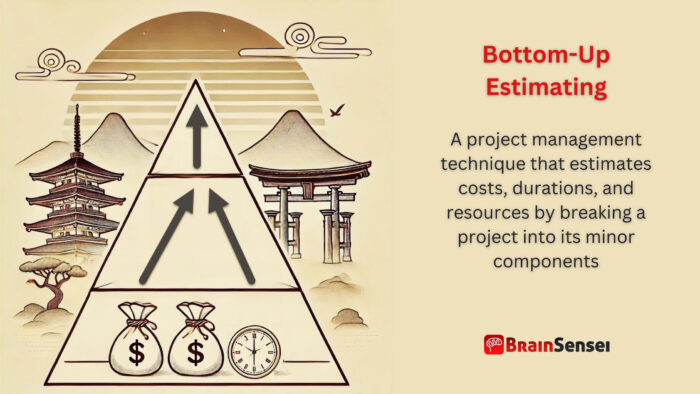
Bottom-Up Estimating
What is Bottom-Up Estimating?
Bottom-up estimating is a project management technique that estimates costs, durations, and resources by breaking a project into minor components. Project managers assess each task separately and then aggregate the estimates to determine the overall project estimate. This approach is known for its accuracy and detailed forecasting capabilities, and it is particularly useful for complex and large-scale projects.
Key Takeaways
- It estimates individual tasks before aggregating them into a total project estimate.
- It is one of the most accurate estimation methods, reducing the risk of cost overruns.
- This method requires detailed project planning and a well-structured work breakdown structure (WBS).
- It can be time-consuming and resource-intensive but provides highly reliable estimates.
- Frequently used in industries where precision is critical, such as construction, IT, and engineering.
Understanding Bottom-Up Estimating
How It Works
Bottom-up estimating begins by identifying all the individual components of a project. Project managers typically organize these components within a Work Breakdown Structure (WBS). Each task within the WBS is estimated separately in terms of cost, time, and resources. The project manager then sums the estimates to determine the project’s total estimate.
- Define the Project Scope: Break the project into manageable work packages.
- Identify Tasks and Activities: List all the tasks required to complete each work package.
- Estimate Costs and Durations: Assess each task’s resources, materials, and time.
- Aggregate Estimates: Combine all individual estimates to generate the overall project estimate.
- Review and Validate: Check for inconsistencies and ensure accuracy through expert validation and historical data comparison.
Key Considerations
- A well-defined scope ensures accurate estimates.
- The accuracy of estimates depends on the quality of data and expert judgment.
- It works best for projects with well-known deliverables and processes.
- Estimators can combine it with top-down estimating for validation and cross-checking.
Related Terms
- Work Breakdown Structure (WBS): A hierarchical decomposition of project work into smaller, manageable sections.
- Parametric Estimating: A technique that uses statistical relationships and historical data to estimate costs and durations.
- Analogous Estimating: Uses historical data from similar projects to estimate costs and durations for a new project.
- Contingency Reserve: An additional budget allocation to cover unforeseen project risks and uncertainties.
- Resource Leveling: A technique that adjusts the project schedule to balance resource availability and constraints.
- Earned Value Management (EVM): A performance measurement method that integrates scope, schedule, and cost data.
Examples of Bottom-Up Estimating
Construction Industry
A construction company is estimating the cost of building a new residential complex. The project manager breaks down the work into components such as excavation, foundation, framing, plumbing, and electrical work. Each task is estimated separately based on labour, materials, and equipment costs. Estimators then aggregate these estimates to form the total project budget, ensuring a precise and detailed cost forecast.
For instance, the excavation phase requires assessing labour costs for workers, rental costs for excavators, and safety gear expenses. The foundation work includes estimating concrete costs, reinforcement steel, and skilled labour. The project team similarly divides framing and plumbing into individual components and then conducts detailed assessments of the materials and work hours required. When all estimates are combined, the construction company has a well-structured budget that accounts for every component, minimizing financial risks and unforeseen cost escalations.
IT & Software Development
The project manager assigns a team to build a new mobile application as part of a software development project. The team breaks down the project into user interface design, database integration, backend development, and testing tasks. Estimators estimate each component individually based on developer hours, software tools, and testing requirements. They then sum the individual estimates to provide an accurate cost projection for project completion.
For example, UI design requires estimating the hours designers spend creating wireframes and prototypes. Backend development involves estimating server costs, API development, and database setup. Testing and quality assurance need estimates for manual testing, automation frameworks, and debugging efforts. Estimators aggregate these estimates to create a comprehensive project cost, thereby financially accounting for all aspects of software development.
Aerospace & Defense
An aerospace manufacturer is developing a new drone for military applications. The project manager divides the project into work packages, including materials procurement, electronic system development, assembly, and testing. Engineers and cost analysts separately estimate each phase to determine the overall project cost, ensuring they do not overlook any critical element.
For instance, materials procurement includes detailed estimates for specialized lightweight metals, avionics components, and sensor systems. The electronic systems development phase requires estimating circuit boards, programming, and AI integration costs. Assembly involves labour costs for engineers, facility rental, and compliance testing. By applying the bottom-up approach, the aerospace firm ensures all drone production elements are precisely cost-effective, preventing budget shortfalls and production delays.
Use Cases of Bottom-up Estimating
United States (Large-Scale Infrastructure Projects)
A government-funded highway expansion project in the U.S. relies on the bottom-up approach to calculate costs for land acquisition, road construction, bridge work, and environmental impact assessments. Each aspect is estimated independently, reducing budget overruns and ensuring financial accountability.
For instance, the cost of acquiring land for expansion is estimated based on market rates, legal fees, and potential relocation expenses for displaced residents. Road construction estimates include raw materials such as asphalt, labour costs, and heavy machinery rental. Additionally, bridge construction requires an assessment of engineering complexity, structural materials, and safety compliance. Project managers use the bottom-up approach to ensure a detailed financial breakdown, preventing budget underestimations.
Germany (Renewable Energy Initiatives)
A wind farm project in Germany uses bottom-up estimating to calculate costs for turbine installation, grid integration, and operational maintenance. This approach allows project managers to predict long-term energy production costs accurately and secure investor confidence.
Each turbine installation is estimated based on the cost of components, transport logistics, and construction labour. Grid integration consists of subcategories, including transformer station setup, cabling costs, and software systems required for load balancing. Ongoing maintenance estimates account for routine inspections, blade replacements, and energy output efficiency tests. With the bottom-up approach, investors gain a transparent breakdown of costs and long-term financial planning.
Japan (Manufacturing Plant Expansion)
A leading automobile manufacturer in Japan uses the bottom-up approach for its factory expansion project. The project team breaks down construction, automation system integration, and labour hiring tasks. This detailed approach helps optimize resource allocation and ensures efficient project execution.
For example, the cost of constructing a new assembly line includes estimates for concrete foundation work, steel reinforcements, and machinery procurement. The integration of an automation system is estimated based on robotic assembly arms, software programming, and quality control mechanisms. Hiring and training costs include wages, onboarding expenses, and skill development programs. The bottom-up estimates clearly project financial requirements, preventing unforeseen costs and delays.
Canada (IT System Upgrade in Financial Services)
A major bank in Canada plans to upgrade its IT infrastructure by implementing a secure cloud storage system. Using bottom-up estimating, the IT team breaks down the project into individual tasks such as server migration, cybersecurity enhancements, and employee training.
For instance, the server migration task includes estimates for cloud service provider fees, hardware decommissioning, and data encryption security. Cybersecurity enhancements involve penetration testing, multi-factor authentication implementation, and compliance audits. Employee training is estimated based on course material development, instructor fees, and software licensing costs. The bank uses the bottom-up approach to ensure a secure and cost-effective system transition without exceeding budgetary constraints.
Africa (Healthcare Facility Development)
A non-profit organization is building a new healthcare facility in Kenya to provide essential medical services to rural communities. The organization uses bottom-up estimating to determine costs for construction, medical equipment procurement, and staffing.
Construction cost estimates include site preparation, structural engineering, and plumbing installations. Medical equipment procurement involves breaking down costs for diagnostic tools, hospital beds, and pharmaceutical storage. Staffing costs include doctor and nurse salaries, administrative staff wages, and continuous medical training programs. The organization ensures an accurate financial plan through bottom-up approach, facilitating efficient donor fund allocation and project completion.
Best Practices for Bottom-Up Estimating
Project managers should follow several key best practices to maximize the effectiveness of bottom-up estimating. Implementing these techniques ensures higher accuracy, better resource allocation, and increased project efficiency.
Develop a Detailed Work Breakdown Structure (WBS)
A well-defined WBS is crucial for the bottom-up approach. The WBS should divide the project into distinct tasks and deliverables, clearly identifying each component. This segmentation allows project managers to estimate costs more precisely and assign resources effectively.
For example, a WBS might include site preparation, foundation work, framing, plumbing, and electrical installation in a construction project. Estimators break down these elements into smaller components, such as labour, materials, and equipment costs.
Use Historical Data for Benchmarking
Historical data from previous projects provides a reliable reference for cost estimation. By analyzing past projects with similar scope and complexity, project managers can refine their estimates and reduce uncertainty. Organizations should maintain a database of historical costs and productivity rates to enhance forecasting accuracy.
For example, an IT company implementing a new software system can review previous software development projects to estimate coding hours, testing costs, and debugging efforts.
Engage Subject Matter Experts
Involving experienced professionals in the estimation process increases reliability. Subject matter experts can provide insights into resource requirements, risk factors, and potential inefficiencies. Their expertise helps validate initial estimates and ensures they do not overlook critical elements.
For instance, engineers, material specialists, and project managers in an aerospace project should collaborate to estimate the costs of components, assembly, and testing procedures.
Incorporate Contingency Buffers
Unforeseen issues can impact project costs and schedules. Contingency reserves help mitigate risks associated with material price fluctuations, unexpected labour shortages, and scope changes. Depending on the project’s complexity and risk profile, contingency reserves typically range from 5% to 20% of the total budget.
For example, contingency funds can cover unexpected environmental challenges in a large-scale infrastructure project, such as unstable soil conditions requiring additional reinforcement.
Regularly Update Estimates Throughout the Project Lifecycle
As projects progress, new information may emerge that affects initial estimates. Continuously monitoring and updating estimates to reflect actual expenditures and changing conditions is essential. Regular updates help avoid budget overruns and keep stakeholders informed.
For example, in a manufacturing project, changes in raw material costs due to supply chain disruptions may require adjustments to cost estimates and procurement strategies.
Utilize Estimation Software and Tools
Project management software enhances the accuracy of bottom-up estimating by providing data-driven insights and real-time tracking. Tools such as Microsoft Project, Primavera P6, and specialized cost-estimating software streamline calculations and improve collaboration.
For instance, an engineering firm can use estimation software to track project costs, generate reports, and compare estimated vs. actual expenditures, leading to better financial management.
Perform Sensitivity Analysis
Sensitivity analysis helps assess how changes in key variables affect project costs. By testing different scenarios, project managers can prepare for potential risks and make informed decisions on budget allocation.
For example, in an oil and gas project, sensitivity analysis can evaluate how fluctuations in fuel prices impact overall production costs, allowing project leaders to develop mitigation strategies.
Foster Communication Among Stakeholders
Clear communication among project teams, clients, and stakeholders ensures transparency in cost estimation. Regular status meetings, detailed reports, and collaborative decision-making contribute to better cost control and alignment with project goals.
For example, in a real estate development project, regular meetings with contractors and suppliers help ensure that cost estimates remain accurate and potential overruns are identified early.
By following these best practices, organizations can improve the accuracy and effectiveness of the bottom-up approach, leading to better financial planning, resource optimization, and project success.
Bottom-up Estimating: Common Mistakes and Issues
Bottom-up estimating is a powerful tool, but it comes with its own set of challenges. Missteps in the process can lead to inaccurate estimates, budget overruns, and scheduling delays. Below are some common mistakes and issues associated with this type of estimating and mitigation strategies.
Underestimating Complexity
One of the most common mistakes is failing to account for a project’s full complexity. When teams break down tasks into smaller components, they sometimes overlook interdependencies or underestimate the time and effort required for each element. These oversights and underestimations can result in project delays and cost overruns.
For example, in a large-scale IT infrastructure project, engineers may accurately estimate the coding effort for software development but fail to account for the integration challenges with existing systems. To mitigate this risk, teams should conduct thorough reviews and seek expert validation at each estimation stage.
Insufficient Historical Data
Reliable estimates depend on historical data from previous projects. Without sufficient reference points, teams may rely on assumptions rather than factual information, leading to inaccurate forecasts.
For instance, a manufacturing company estimating the cost of a new production line may miscalculate labour costs if it does not analyze past projects with similar complexity. Organizations should maintain a well-documented project history database and regularly update benchmarks to avoid this.
Ignoring Risk Factors and Contingencies
Many project managers focus solely on expected costs and durations without accounting for risks and uncertainties. Unexpected delays, supply chain disruptions, or labour shortages can significantly impact project outcomes.
For example, material price fluctuations in construction projects can affect overall costs. If global market conditions change, a project that initially estimated steel at a fixed rate may face budget overruns. To mitigate such risks, teams should incorporate contingency reserves into their estimates, typically ranging from 5% to 20%, depending on project complexity.
Overlooking Soft Costs
While direct costs like materials and labour are typically well-accounted for, teams often neglect indirect costs such as training, project management, and compliance. These soft costs can add up and impact the project’s financial viability.
For example, a healthcare facility expansion may focus primarily on construction costs but overlook expenses associated with regulatory compliance, staff onboarding, and system integration. To prevent this oversight, estimators should comprehensively categorize costs, including direct and indirect expenses.
Inconsistent or Overly Optimistic Estimates
Another challenge with the bottom-up approach is inconsistent estimates provided by different team members. If various departments or individuals contribute separate estimates without alignment, discrepancies can arise, leading to miscalculations.
For example, engineers estimate component costs in an aerospace project, while procurement teams estimate vendor expenses. The final budget may be unrealistic if estimators do not cross-check these estimates. Conducting iterative reviews and cross-functional validation ensures consistency and realistic forecasting.
Excessive Detail Leading to Inefficiencies
While the bottom-up approach aims for accuracy, excessive granularity can become counterproductive. Overloading the process with too many sub-tasks can slow decision-making and create unnecessary administrative burdens.
For instance, an IT software development team may divide coding efforts into microscopic tasks, resulting in unnecessary effort tracking and reporting. To avoid overcomplication, it is crucial to balance detailed estimates and efficiency.
Failure to Update Estimates as the Project Progresses
Many teams treat the bottom-up numbers as static figures rather than dynamic values that should evolve with project conditions. Failure to update estimates in response to changing circumstances can lead to budget overruns and unrealistic timelines.
For example, unexpected regulatory changes in a transportation project might require additional approvals and safety measures. Failure to incorporate these factors into the estimate revisions will result in an inaccurate final cost projection. Regularly reviewing and updating estimates ensures ongoing alignment with project realities.
Conclusion: While the bottom-up approach is one of the most accurate estimation techniques, it requires careful planning and execution to avoid common pitfalls. By considering the complexity, historical data, risk factors, soft costs, and regular updates, project managers can significantly enhance the reliability of their estimates. Proper execution leads to better financial planning, resource allocation, and project success.
Bottom-up Estimating: Frequently Asked Questions (FAQs)
How does bottom-up estimating differ from top-down estimating?
Bottom-up estimating calculates costs from individual tasks upwards, while top-down estimating starts with an overall estimate and breaks it down into smaller parts. Bottom-up is more detailed and accurate.
What industries benefit most from bottom-up estimating?
Cost estimation, which requires precision, benefits industries with complex, resource-intensive projects, such as construction, aerospace, IT, and manufacturing.
What are the challenges of bottom-up estimating?
It requires significant time and effort, relies on accurate data, and can be costly regarding resource allocation. However, its accuracy often outweighs these challenges.
Can bottom-up estimating be combined with other estimation techniques?
Yes, it is often used with analogous or parametric estimating to cross-validate results and improve estimate reliability.
How can project managers improve bottom-up estimating accuracy?
Leveraging historical data, involving experts, and continuously updating estimates as the project progresses.
Additional Resources
- Project Estimating and Cost Management (Project Management Essential Library)
- Project Cost Estimation: How to Estimate Project Cost
Preparing for a PMI certification?
- Exam Prep Courses: PMP®, CAPM®, and PMI-ACP®
- Exam Simulators: PMP®, CAPM®, PMI-ACP®, PMI-PBA®, PMI-RMP®, PMI-SP®, PgMP®, and PfMP®
- Professional Development Units (PDUs): 15, 30, and 60 PDU Bundles



